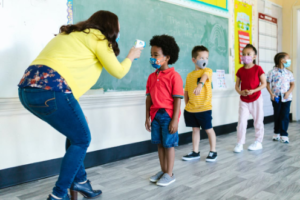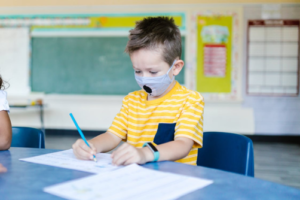Pandemic Children Learning “How to Do School” For the First Time
By Maria Khan & Aaron Leo
There is an entire generation who will look back to themselves as “pandemic children” in the years to come. For many of them, this has been the first time they are in elementary classrooms learning not just how to read or write and do math, but rather “how to do school” during a pandemic.
Learning “How To Do School” For the First Time in a Pandemic
For many children, COVID-19 disrupted their little worlds when they were in daycare, preschool, or kindergarten. Now in first or second grade, they are realizing that expectations are different than what they remember in those early childhood learning environments. Previously able to move around classrooms and be in close contact with their peers and teachers, now these children are expected to stay at their desks, wear masks, and sometimes stay behind barriers between themselves and their peers and teachers. For a large number of students who entered kindergarten this year and are in school for the very first time straight from home or a daycare facility—the change is immense.
 Transitions can be hard for young children and families. Young children often have what is commonly known colloquially as “stranger danger” that can make relationship-building with their teachers take time. Until they are old enough to talk about their feelings, it is hard for children to explain what is causing anxiety. For children with developmental delays, it can take even longer to nurture relationships. It is also difficult for children to know what the expectations may be inside a classroom, especially taking into account constantly changing social distancing rules, despite conversations with parents who attempt to prepare them for school.
Transitions can be hard for young children and families. Young children often have what is commonly known colloquially as “stranger danger” that can make relationship-building with their teachers take time. Until they are old enough to talk about their feelings, it is hard for children to explain what is causing anxiety. For children with developmental delays, it can take even longer to nurture relationships. It is also difficult for children to know what the expectations may be inside a classroom, especially taking into account constantly changing social distancing rules, despite conversations with parents who attempt to prepare them for school.
Elementary schools provide more than just academic growth opportunities to children – they are places of stimulation, enrichment, and acquisition of social and emotional skills. There is growing evidence that elementary school children have been uniquely impacted by the pandemic, having experienced interruptions during a critical time of physical, social, and emotional development. Compounding these effects, many young children have experienced the trauma of losing a loved one and/or experienced financial, housing, and food insecurity which also correlates with mental health and emotional well-being.
For a five or six-year-old entering an unfamiliar building for the very first time, trying to get to know their peers or teachers while behind their masks, can be intimidating. And as has been reported in local and national media, just two months into the school year and stories of “meltdowns” and subsequent application of “time-out zones” in classrooms are becoming common-place.
Children, Family Members, Teachers and School Leaders: It Takes a Village to Support Young Children
Great emphasis has been placed on making schools safe and on preventing the coronavirus spread, but there is also an emergent need to be prepared to recognize signs of anxiety, distress, and grief among young children attempting to learn how to do school this school year.
It is critical that parents, teachers, and school leaders all come together to support children through these unusually challenging times.
An important lesson and reminder from the past two years is that while young children may have hiccups growing up during a pandemic, children are typically quite resilient, adaptable, and can thrive with appropriate and effective support.
Here are some suggested strategies to help young children adapt and adjust to “learning to do school” this year:
- Staying calm and providing reassurance
- Establishing connections through technologies such as video calls
- Meeting outside on the playground or other outdoor places to let children connect with peers and teachers
- Developing effective two-way communication strategies with all stakeholders
- Inviting many opportunities for students to have a voice
- Creating safe spaces to care for children who have experienced trauma
- Asking children explicitly what they need
NYKids Findings from Elementary Schools
 Throughout the pandemic, educators have faced unique challenges and incredible pressure. From quickly adapting to remote learning to balancing the impacts of the pandemic on their personal lives, the past year has seen educators particularly overwhelmed with stress, trauma, and burnout. This year brings them new challenges in meeting the needs of first-time elementary school students who have grown up in a pandemic with all of the social distancing and isolation that has entailed.
Throughout the pandemic, educators have faced unique challenges and incredible pressure. From quickly adapting to remote learning to balancing the impacts of the pandemic on their personal lives, the past year has seen educators particularly overwhelmed with stress, trauma, and burnout. This year brings them new challenges in meeting the needs of first-time elementary school students who have grown up in a pandemic with all of the social distancing and isolation that has entailed.
In our ongoing study “Discovering Impacts of the COVID-19 Pandemic on the Education Workforce,” we have found substantial increases in stress and job dissatisfaction among educators since the start of the pandemic. In addition, our study provides evidence that collaboration among educators weakened during the pandemic.
These findings extend to our sample of 22 elementary schools and hundreds of elementary school teachers working in them who described the unique challenges facing elementary school students in the open-ended section of the NYKids’ survey. Many elementary school educators, for instance, reflected on the difficulty of maintaining student and staff safety and following social distancing guidelines with young children. One elementary school teacher explained how the effects of the pandemic has had deep impacts on their students’ social-emotional health:
The effects of the pandemic on children is profound. They wear their masks, wash their hands, and follow social distancing rules but often talk about just wanting to sit next to a friend and they miss having playdates. The pandemic has magnified for me the importance of nurturing the whole child. The academics can’t happen if a child is worried or scared. I let my students talk about their feelings and let them know that this won’t be forever and that I understand how hard it is.
Another elementary school teacher reflected on how the isolation brought on by the pandemic and the logistical challenges of teaching remotely has had adverse effects on their students:
[My students] are so needy for confirmation and attention. I get to be another adult in their lives to listen to them and hear about their lives outside of school. That is so important. I don’t think all students get that. I think some students go through their days without being really seen. It is tough to run a classroom, while attending to virtual students, constant sanitizing and mask wearing. Hard to speak and be heard by a classroom full of kids.
As the NYKids research team continues to analyze data, we will be providing new reports and resources for educators at all levels to use as they tackle pandemic-related challenges.
Thank you for your interest in NYKids, and please stay tuned for the continued dissemination of our findings from this study.
We encourage you to reach out to nykids@albany.edu with your feedback and requests for direct support.
